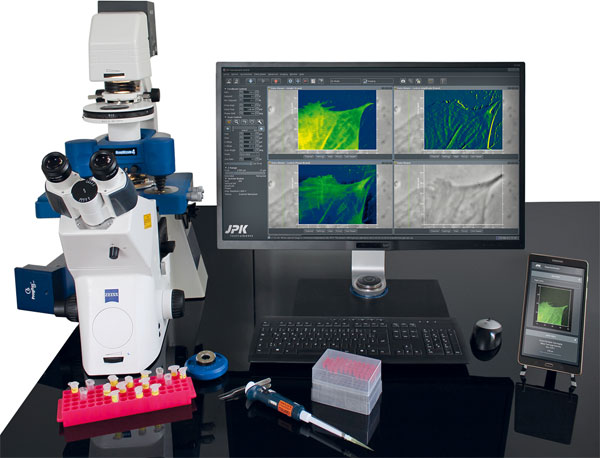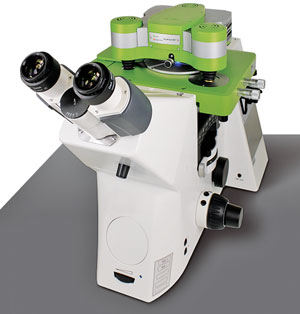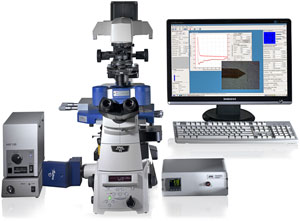Biological AFM and Microscopy Systems from JPK Instruments / Bruker
 We are pleased to add the JPK Instruments range to our portfolio, which is now part of the Bruker Nano Surface Analysis family. The new range includes biological microscopy instrumentation, including:
We are pleased to add the JPK Instruments range to our portfolio, which is now part of the Bruker Nano Surface Analysis family. The new range includes biological microscopy instrumentation, including:
- AFM
- Automated force spectroscopy
- Optical tweezers and optical trapping
- Cell/tissue mechanics and adhesion
Blue Scientific is the official distributor for Bruker Nano Surface Analysis in the Nordic region (Denmark, Iceland, Norway, Sweden and Finland). If you have any questions, please get in touch.
Bruker Nano Surface Analysis
Contact us on +44 (0)1223 422 269 or info@blue-scientific.com
JPK Instruments
JPK Instruments was acquired by Bruker in July this year. They provide microscopy instrumentation for:
- Biomolecular imaging
- Cellular imaging
- Force measurements on single molecules, cells and tissues
Their systems complement the existing Bruker range for neuroscience, live-cell imaging and molecular imaging. They are used for life science applications including:
- Live cell imaging
- Cellular mechanics
- Adhesion and molecular force measurement
- Optical trapping
- Biological stimulus-response characterisation
Optical Tweezers and the Nobel Prize
The JPK range includes optical tweezers, which have taken the spotlight this week. Congratulation to Dr Donna Strickland, Dr Arthur Ashkin and Dr Gerard Mourou who’ve been awarded the Nobel Prize for their work in laser physics.
It was Dr Ashkin who first developed the optical tweezer technique. Dr Strickland and Dr Mourou developed high intensity laser technology with chirped pulse amplification (CPA), making it a viable and practical technology.
Together, their work created optical tweezers that can be used to hold particles, atoms, viruses and living cells without harming them.
Optical tweezers are now commercially available from JPK Instruments with the NanoTracker 2 and OT-AFM Combi-System, which combines them with an AFM microscope.
As an example, the video below shows a single DNA molecule manipulated by two optical traps in the NanoTracker. The invisible molecule is indicated by the extension of the left particle from its trap (the crosshair). The system records the force exerted, to measure the elastic response of the DNA at increasing tension.
[hr]Product Range
The JPK range covers a variety of microscopy-related techniques:

Atomic Force Microscopy
JPK’s NanoWizard combines AFM with optical microscopy, with seamless overlays to correlate your data easily. Their QI Mode makes quantitative imaging easy, with an intuitive, automated workflow.
The flagship of the range is the NanoWizard 4 BioScience AFM , which combines atomic force imaging with advanced optical fluorescence imaging and super-resolution microscopy. This gives you optimal image resolution for molecules, membranes and live cells.

Automated Force Spectroscopy
Force spectroscopy is a single molecule technique for studying molecular interaction at the nanoscale. It is highly sensitive, and can even be used to characterise the unfolding forces of individual proteins and single chemical bond forces.
The JPK ForceRobot is an automated force spectroscopy platform that speeds up the technique, giving you high quality data in a short time-frame, together with optional temperature control and fluidics systems.
This enables you to study receptor-ligand interactions and small molecule-protein binding interactions.
![]()
Optical Tweezers and Optical Trapping
Dual beam force-sensing optical tweezers that can be integrated into inverted optical microscopes – for the first time. This combines advanced optical and confocal techniques, including single molecule fluorescence.
With JPK’s unique tweezer technology (Photonic Force Microscopy) you can quantify molecular, cellular and micro-rheological processes. This is useful for studying molecular motor mechanics, DNA and protein binding/elasticity, cell membrane dynamics and particle uptake in cells.
The NanoTracker™ optical tweezer is an all-optical means for molecular and cellular force experiments. It’s used in a huge variety of fields. In material science and soft matter alone, applications include characterising mechanical properties such as adhesion, viscoelasticity and deformation, as well as optical, thermodynamic or nanomanipulation experiments with trapped particles.

Cell/Tissue Mechanics and Adhesion
Quantify single cell-cell and cell-surface interactions under physiological conditions. This technique is known as single cell force spectroscopy (SCFS). It measures the interaction forces between a living cell on a cantilever and a target cell, functionalised substrate, tissue or biomaterial. You can also simultaneously measure biomechanical characteristics, including stiffness and elasticity.
JPK’s CellHesion platform brings quantitative force measurement to live cells and tissues, for insights into cell-substrate and cell-cell interactions.
Further Information
Full details of these systems will be added to our website shortly. For now, if you’d like more information please get in touch:
Contact us on +44 (0)1223 422 269 or info@blue-scientific.com
Bruker Nano Surface Analysis


